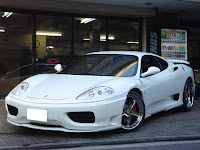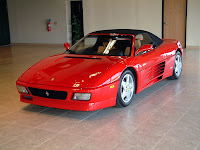Ferrari FXX
The Ferrari FXX is a race car developed as part of an unusual development program by automobile manufacturer Ferrari in Maranello, Italy. Production of the FXX began in 2005.
The car uses some technology developed from the Enzo and combines it with some all-new developments from Ferrari and some of the suppliers. However, the car is only a part of the overall program: customers pay £1.3 million ($2.5 million USD) but are only allowed to drive the car on special track days approved by Ferrari and after they drive the car they have to brief Ferrari on the car's performance. Michael Schumacher was given the last one (number 30) when he retired from Formula One racing at the end of 2006. Ferrari's sister company, Maserati, has developed a similar car, the MC12 Corsa.
Essentially an evolution of the Enzo, the FXX shares some components with its parent car, but significant portions are exclusive to the FXX.
The FXX's engine is based on the Enzo's but has been expanded to 6.3 L (6262 cc, 382.1 cu in) from 6 L (5988 cc, 365.4 cu in), and output has been boosted from 660 PS (651 hp/485.4 kW), as seen in the Enzo, to 812 PS (800.9 hp/597.2 kW) at 8,500 rpm.
The gearbox incorporates the latest developments from Ferrari's F1 program and has a shift time under 100 ms. The brake pads are upgraded compared to those on the Enzo. It does, however, retain the ceramic discs found on the Enzo.
The tires on the FXX are 19 inch slicks custom-developed for the car, though road-legal.
As with the Enzo, the seat and pedal configuration are custom fit to the user's exact measurements.
The FXX features a comprehensive data-monitoring and telemetry that not only allows the driver to improve performance, but also provides Ferrari technicians with valuable data to improve the FXX and future road-going Ferraris.
Ferrari has built 30, originally 29 of these cars, and they have all been sold to preselected past Ferrari customers, except for one that Ferrari S.p.A. kept, including Ferrari's F1 World Champion driver, Michael Schumacher, the 30th. Schumacher's FXX differs from others in that it is the only black FXX without a stripe, it comes with red trim on the wheels, it has matte exhaust tips (regular FXX's have chrome tips), and his personal logo is stitched on the racing seats.
FXX owners also participate in Ferrari's testing and brand development programs. As the vehicle is not street-legal, owners have the option of storing the car at Ferrari's facilities. As part of the FXX program, the car is maintained by the Ferrari factory. The purpose of this particular program is to allow Ferrari's top customers exclusive access to its most up-to-date technology and to use their input to help develop future models. The FXX was reported to cost 1.5 million euro (excluding taxes), for the car and the services that Ferrari provides with it.


















































